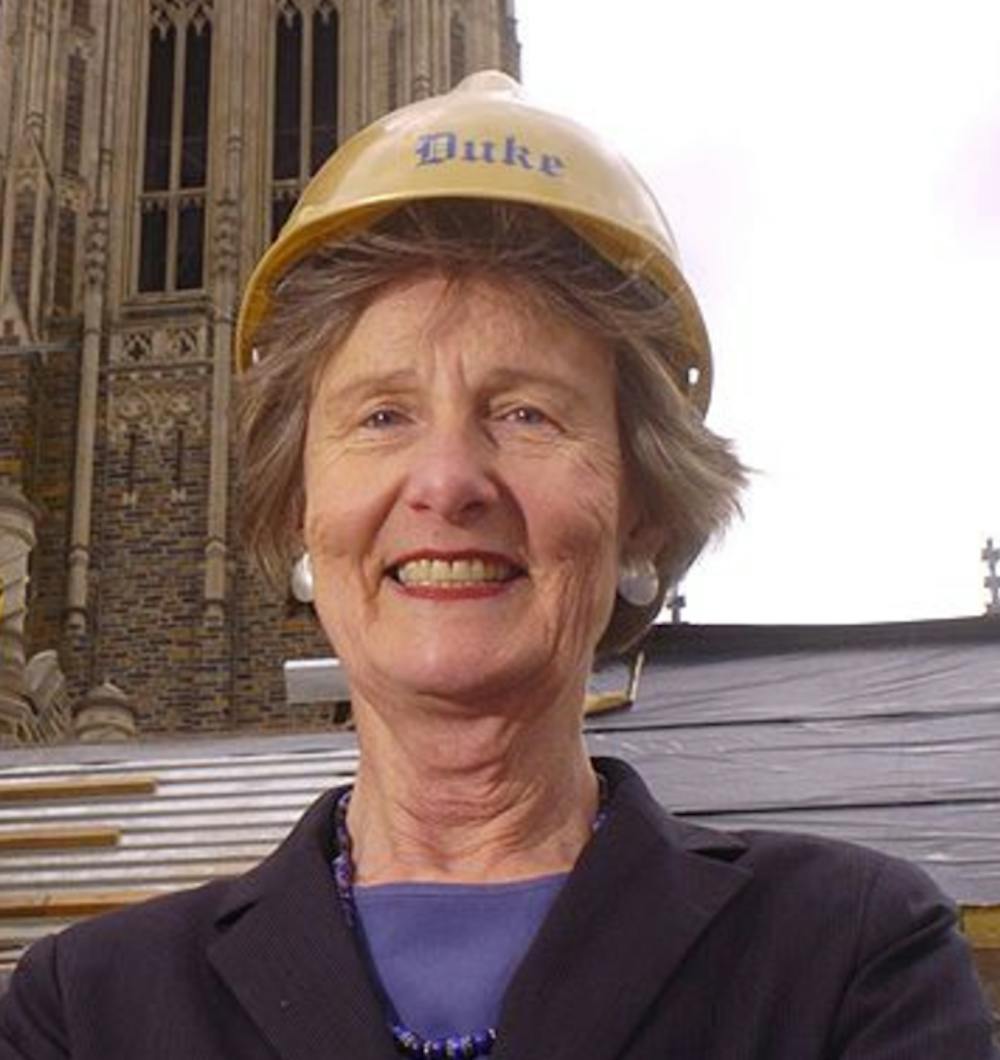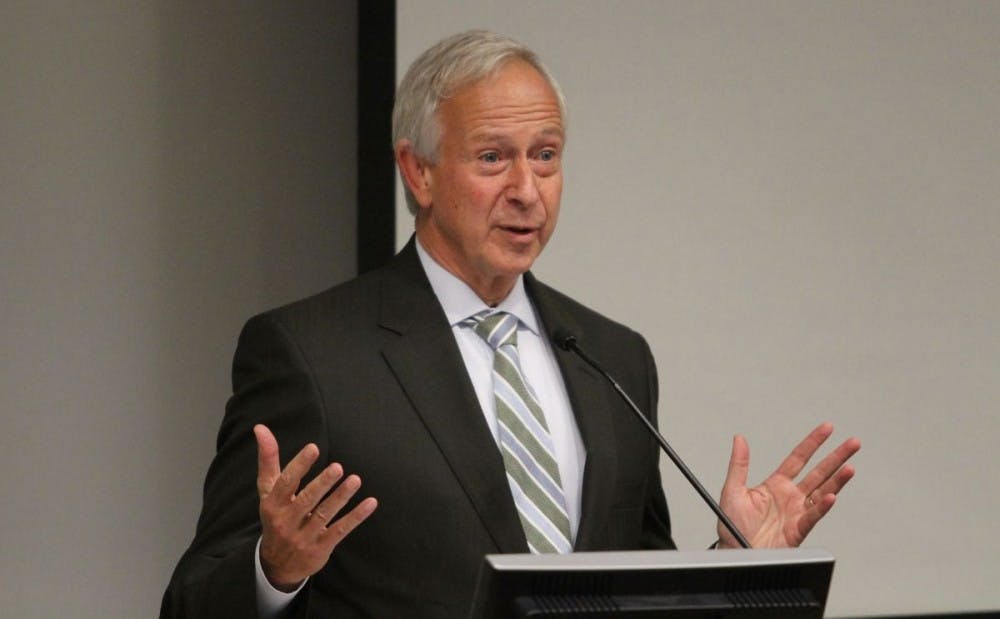It has been three months since former President Richard Brodhead left office—what’s he been up to since then?
When he announced his retirement last April, Brodhead told the University community that he would take a one-year sabbatical before likely returning to teaching or writing—"the passions that lured [him] to academic life in the first place.”
The Chronicle reached out to Brodhead, but after 13 years of being in the limelight, he wanted to avoid the spotlight for the time being. But he will be back for President Vincent Price’s Oct. 5 inauguration.
“You can report that I am doing unimaginable things in an undisclosed location!” Brodhead wrote in an email.
How have prior Duke leaders adjusted to life after the presidency? Let’s start at the beginning.
Advancing education outside Duke
Brantley York was the was first president of the Union Institute in Randolph County, which would eventually became Duke University. His presidency lasted from 1838 to 1842—four short, but important, years at the school.
In “The Autobiography of Brantley York,” he describes his time as president as “truly onerous,” with his “faculties both mental and physical having been taxed to their utmost capacity.” He also began going blind during his time at the Institute.
After leaving, he continued to work in education. He was a professor at Rutherford College in North Carolina, teaching English, rhetoric and logic. He helped establish three high schools and two colleges, while simultaneously publishing three books on grammar and one on mathematics and the law.
York was also an avid preacher, traveling across the country to preach an estimated 8,000 times. In addition, he served as president of a temperance society and ministers’ conference. York never returned to the Union Institute, instead focusing on other aspects of higher education.
Like York, Nannerl Keohane—who preceded Brodhead and served between 1993 and 2004—pursued her educational interests away from Duke after her term ended.
She focused on education and leadership equality for women and minorities and became a distinguished visiting professor at Princeton University, where she chaired a committee on women’s leadership.
This committee found that there were “differential rates at which women and men were going into leadership,” Keohane said in an interview with the publication “AboutCampus.” She and the committee worked to develop methods to improve mentorship at Princeton.

She also continued to serve on many committees, including Harvard’s governing body despite not having a degree from Harvard. In 2008, Keohane became the chair of the board of trustees for the Doris Duke Charitable Foundation, which supports the performing arts and environmental conservation. She still serves as one of the board’s members.
John Kilgo—president from 1894 to 1910—had a bittersweet relationship with Duke after his presidency. Following his tenure, Kilgo became a member of the Board of Trustees and was elected as its chair in 1915.
However, an incident on campus impaired his relationship with Duke. A few sophomore students hoisted a pendant with their graduation year ‘17 up a campus flagpole, which Kilgo considered “treasonable” and a defilement of the U.S. flag. He publicly denounced these students, but many people believed Kilgo’s reaction was too severe.
Following much conversation back and forth with the Class of 1917, Kilgo refused to offer degrees to the students who committed the offense, but the Board of Trustees overruled his decision. Soon after, Kilgo resigned as a trustee and president emeritus.
However, he continued to pursue a career in education and as a preacher. He was a member of the education commission for the Methodist Episcopal Church South, which founded Emory University in 1915. Kilgo served as vice chair of Emory's board of trustees from 1917 until his death in 1922. He was also a bishop for Annual Conferences—a regional meeting for the Methodist Church—and continued to attend the conferences even in faltering health.
Other presidents, however, interacted more significantly with the University after leaving office.
Get The Chronicle straight to your inbox
Sign up for our weekly newsletter. Cancel at any time.
Coming full circle
Terry Sanford—president from 1969 to 1985—became very involved with North Carolina politics. He began his political journey while still in office, campaigning for the Democratic presidential nomination in 1972. Knowing that winning the primary was a longshot, his goal was to contest Alabama governor George Wallace and his segregationist ideas. Sanford eventually came up short and finished fifth in the primary race.
Two years later, Sanford bounced back. He began campaigning for the presidential nomination for 1976, all while still at Duke. But a medical condition, a heart murmur, forced him to withdraw from the primaries.
Sanford’s difficulties continued after he stepped down from the presidency. He lost the election for chairman of the Democratic National Convention in 1985. It was not until Republican Senator John East committed suicide in 1986 that Sanford ran and won the North Carolina senate race.
As senator, he focused on anti-poverty reform, education improvement and equality for minorities.
He also lead the Duke-based International Commission for Central American Recovery and Development, which wrote a report promoting peace and equity in Central America.
After his time as senator, Sanford returned to Duke to teach political science and law. He was a major factor in the campaign for a performing arts center in the Research Triangle. Like York, Sanford was a prolific author, publishing three books about about education, aging and government.
Brodhead’s political agenda may not be as ambitious as Sanford’s, although “President Brodhead” has a nice ring to it—of the United States, of course.
Arthur Hollis Edens, who served as president from 1949 to 1960, also continued to contribute to Duke after his term ended. The University persuaded him to remain a consultant at Duke for 10 years at a salary of $18,000. According to the Duke Archives, “Dr. Edens had continued to maintain his residence in Durham after giving up his post at Duke. He had continued active in Durham civic and educational affairs until going to Atlanta earlier for treatment at Emory Hospital.”
During his time as consultant, he was the first executive director of the Mary Reynolds Babcock Foundation, which awarded grants of up to six million dollars for charities and educational institutions to fight poverty in the South.
Robert Flowers—president from 1941 to 1948—assumed a new role at the University after his tenure as president. He became the first chancellor of Duke, in addition to acting as an advisor and being awarded lifetime tenure.
“Dr. Flowers will be enabled to enjoy a well-deserved rest and still remain active in the affairs of Duke,” wrote the Duke Alumni Register.
Flowers continued to be a leader in the Durham community, serving on the board of five different institutions—including colleges, orphanages, and hospitals. He was a director for the Durham Chamber of Commerce, Durham YMCA, Durham and Southern Railway and Fidelity Bank of Durham. Flowers was also a member of Rotary International–a charitable society of business professionals—and served on the board of education for the Methodist Church.
Another president Keith H. Brodie—who served between 1985 and 1993—returned to work as a full-time professor at the University, teaching psychiatry and behavioral science.

He developed a behavioral science course for the Duke Law School, worked with students doing independent studies and taught a first-year seminar in psychobiology. He also wrote a book compiling his speeches and his reflections as president.
“This is a great place. I return, almost in a parabolic way, to the faculty trenches I left,” Brodie told the Herald Sun.
What Brodhead will do after his sabbatical is anyone’s guess. Some students said they were excited about the idea that Brodhead could return to teach.
“I would definitely take a class with him,” senior Pablo Vivas said. “It’s nothing much more than his reputation as very well spoken and academic.”

